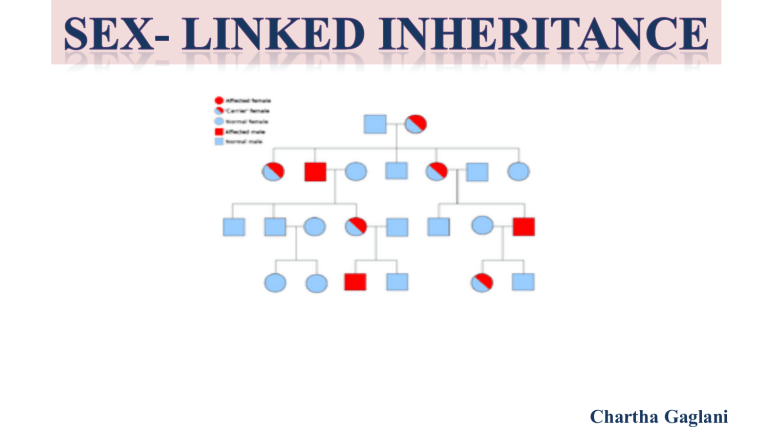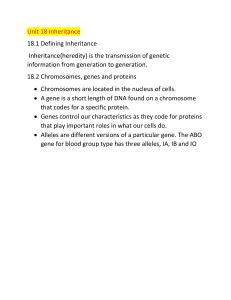
Chartha Gaglani CONTENTS • What is sex linked inheritance? • Types 1. X-linked inheritance ( Colour Blindness and Haemophilia ) 2. Y-linked inheritance ( Hyperterichosis, Ichthyosis hysterix ) 3. Completely sex linked inheritance 4. Incompletely sex linked inheritance SEX-LINKED INHERITANCE • The inheritance of a trait (phenotype) that is determined by a gene located on one of the sex chromosomes is called sex linked inheritance. • The genes controlled by genes located on the sex chromosome is called sex- linked inheritance. • It was discovered by T. H. Morgan in 1910. • The genes controlling body characters located on X chromosomes are called X-linked genes. • The inheritance of X-linked genes is called X-linked inheritance. • The characters controlled by X-linked genes are called X-linked characters. • Eg: Haemophilia, color blindness etc. • The genes controlling body characters located on Y chromosome are called Y-linked genes. • The inheritance Y-linked genes is called Y-linked inheritance. • The characters controlled by Y-linked genes is called Y-linked characters. • Eg: Hyperterichosis, Ichthyosis hysterix. • The genes controlling body characters of both and X and Y chromosome is called XY linked genes. • The inheritance of XY linked genes is called XY linked inheritance. • The characters controlling the XY linked genes are called XY linked characters. • Eg: Nephritis, Xeroderma pigmentosum etc. • Most of the sex linked genes follow the crisscross inheritance (zig zag). • The inheritance of a character from the father to his grandson through his daughter is called criss-cross inheritance. X-LINKED INHERITANCE • Certain sex linked genes are located only on X chromosomes and their alleles are absent from Y chromosome. • These genes are called X linked genes, the characters controlled by these genes are called X linked characters and their mode of inheritance is called X linked inheritance. • Eg: Colour blindness, Haemophilia etc. COLOUR BLINDNESS • Colour blindness is a sex linked character discovered by Wilson in 1911. • Hereditary disease and the affected person cannot distinguish between red and green colour. • Red blindness is called protonopia and green blindness is called deutronopia. • Colour blindness is a recessive character. • Caused by recessive genes represented by cc. • Normal person contain genes CC or Cc or C alone ( in man ). • The genes for colour blindness are located on the X chromosome, their alleles are not present on Y chromosome. • So man has only one gene. The presence of only one gene for a character is called hemizygous. So man is hemizygote for colour blindness. • • • • This character is common in man then in woman. Follows criss-cross inheritance. Never transmitted to son from father. Daughter carrying one recessive gene for colour blindness is called carrier. HAEMOPHILIA • Also called as Bleeder`s disease. • Characterized by delayed blood clotting. • This is because of the absence of antihaemophilic globubin which plays an important role in blood clotting. • In normal person, blood clots in 2 to 8 minutes but in haemophilic patients, clotting is delayed for 20 minutes to 24 hours. Hence they bleed continuously from the wound. • Queen Victoria was also affected by this disease and it was transmitted to her descendants. • Hence this disease is common among the Royal Family Of Queen Victoria and so it is also called as Royal disease. • It is a sex linked recessive character. • Cause by recessive gene represented as hh and normal condition is due to dominant gene H. • • • • • The genes are located on X chromosome. Male is homozygote. Disease is common in male then in female. Follows criss-cross inheritance. Generally Haemophilic patients will die before reaching reproductive stage. Y-LINKED INHERITANCE • The sex linked genes located on Y chromosomes are called Y linked genes. • The Y linked genes are confined to males only. • Hence they are called Holandric genes ( Holos-whole; andros-male ). • These genes are transmitted directly from father to the son. • Their mode of inheritance is called Y linked inheritance. • Eg: Hyperterichosis, Ichthyosis hysterix etc. XY LINKED INHERITANCE • Certain sex linked genes are located on both X and Y chromosomes. • They are called XY linked genes and their mode of inheritance is called XY linked inheritance. • Eg: Xeroderma pigmentosum, nephritis, retinitis pigmentosa etc. COMPLETELY SEX-LINKED INHERITANCE • The X and Y chromosomes are not similar. • X chromosome is larger then Y chromosome. • The lower part of both the chromosomes are similar. These two parts are called homologous regions. They have same type of genes. • The remaining part is not similar. They are called non-homologous regions. Do not contain similar type of genes. • The genes located on non-homologous regions inherit together because crossing over does not occur in these regions. • The genes located on non-homologous regions are called completely sex linked genes and their inheritance is called completely sex linked inheritance. • Eg: Haemophilia, colour blindness etc. INCOMPLETELY SEX LINKED INHERITANCE • The genes located on homologous regions of sex chromosomes do not inherit together because crossing over may occur in these regions. • So these genes are called incompletely sex linked genes and their mode of inheritance is called incompletely sex linked inheritance. • Eg: Retinitis pigmentosa, nephritis etc. THANK YOU…



